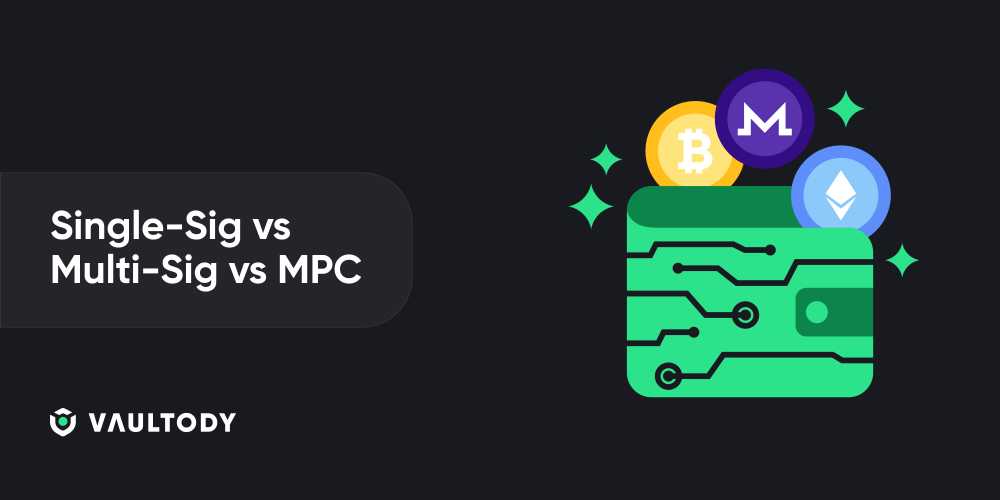Different approaches of how you can manage your cryptographic keys or secure your cryptocurrency possession exist. Three of the most widely used are the Single Signature (Single-sig), Multi-Signature (Multi-sig) and Multi-Party-Computation (MPC).
We will provide an overview of all three, focusing on their functionalities, privacy and security aspects, to give you a better understanding of the advantages and disadvantages based on your goals.
1. Single-sig
This method has the lowest protection level, but it is the most common due to its convenience element that it brings to the user and the ease of use. However, the fact that there is only one signer with one private key who can authorize and verify a transaction is making the single-sig the most vulnerable approach.
- Advantages of the single signature
Simple to use - you can gain access with just setting up a single account (username and password) which can give you access to multiple functionalities
Efficient - only one signature is required, which can save time, it is more convenient for the user and can eliminate the need to create and remember multiple usernames and passwords
Provides streamlined access - move from one service or functionality to another without having to re-authenticate
- Disadvantages of the single signature
Low level of security - it is easier to compromise a single set of credentials which can potentially provide access to multiple services, applications or systems to the attacker
Higher failure probability - by failure we mean higher risk of losing access to all resources by getting your single set of credentials stolen or lost
Lack of privacy - typically a provider or an authority is managing users` credentials, which raises concerns of tracking users
2. Multi-sig
Unlike the single-sig method, multi-sig requires two or more private keys, and respectively users who are authorized to validate a transaction. Each of the signees is in possession of their own private key. In order for a transaction to be completed, all signatures are required.
- Advantages of the multi-sig
Higher level of security - multi-sig adds an additional layer of security, requiring additional signees to participate in the authorization process. This makes it significantly more difficult to unauthorized individuals to gain access
Diminished risk of unwanted access - in the scenario of a signee which loses their credentials, unauthorized individuals will not be able to gain access unless other signees participate in the authorization process
Customization - different roles and levels of authority can be assigned to all signees, providing enhanced control and limits the risks of internal threats
- Disadvantages of the multi-sig
Increased complexity - since multiple users are involved in the process, it is more difficult to create and use multisig wallet than using a single-sig
Risks of delays - the authentication which requires multiple party to all authorize a transaction could lead to delays, which could be pivotal in time-bounded operations
Dependencies and challenges - transactions depend on the involvement of all signees into the process, which could create barriers if someone becomes unresponsive, unavailable or if there are internal coordination issues
Adoption difficulties - only certain protocols support multi-sig wallets and those that support it may require additional technical activities to be undertaken; From the user`s side there may be training sessions required for onboarding new signees
Higher fees - each transaction requires the signatures of all parties. Fees are entirely dependant on the size of the transaction and number of signees who authorize the transaction. The higher the number of signees, the higher the fees that users have to pay
3. MPC Wallet
MPC wallets are similar to the multi-sig in a sense that multiple parties can authorize a transaction. However, what makes an MPC wallet different is the multi-computing technology, which splits the private key into different encrypted fractions (shares). Each signee holds a share of the key which when combined with the other signees shares unlocks the wallet functionalities. It is important to note that the encrypted shares of each signee might be dynamic and may be divided between several devices.
- Advantages of the MPC wallet
Highest level of security and privacy - distributed and shared control of the wallet between all parties; each party's input is encrypted;
Very low risk associated with hacks/thefts - keys are not shared which eliminates external vulnerabilities and threats
Distributed trust - the distributed trust relies on the input of all participants, making it suitable for scenarios where mutual mistrust or lack of trusted central entities is present
Applicability - by design MPC wallets can be customised to suit as many users as needed and as many blockchains as required without compromising privacy or competitiveness
Lower transaction fees compared to Multi-Sig as the signing process is done off chain.
- Disadvantages of the MPC wallet
Complex and time consuming - privacy and security come at the cost of the MPC technology being a little bit more complicated, but the benefits it provides against the extra efforts and time needed are fully-justified
Still in its early days - there are not that many providers on the market as of time of writing
Final thoughts
The security and privacy level that MPC wallets bring to the table is unmatchable by neither the single=signature nor the multi-party signature wallet. This is where Vaultody MPC wallet excels and can provide the ideal setting for managing multi-party transactions. MPC wallets use cases can vary, but we are aware that most of our clients find the multi-computing technology useful in B2B businesses, where full control, privacy and maximum protection on transactions is needed.









 Copy link
Copy link